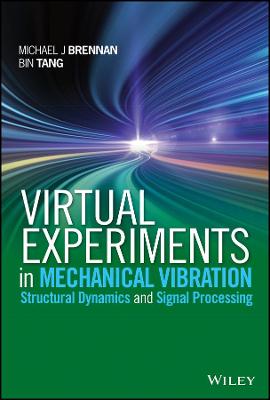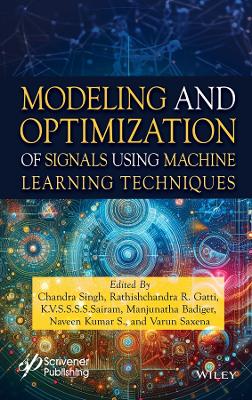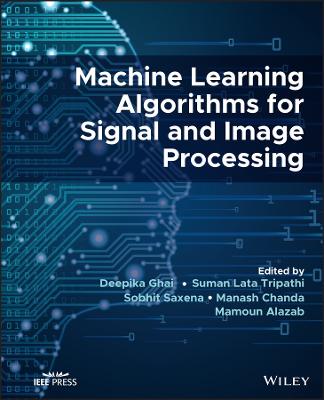Virtual Experiments in Mechanical Vibrations
 -15%
portes grátis
-15%
portes grátis
Virtual Experiments in Mechanical Vibrations
Structural Dynamics and Signal Processing
Brennan, Michael J.; Tang, Bin
John Wiley & Sons Inc
10/2022
336
Dura
Inglês
9781118307977
15 a 20 dias
Descrição não disponível.
Preface xiii
List of Abbreviations xv
List of Symbols xvii
About the Companion Website xxi
1 Introduction 1
1.1 Introduction 1
1.2 Typical Laboratory-Based Vibration Tests 3
1.3 Relationship Between the Input and Output for a SISO System 5
1.4 A Virtual Vibration Test 6
1.5 Some Notes on the Book 7
References 7
2 Fundamentals of Vibration 9
2.1 Introduction 9
2.2 Basic Concepts - Mass, Stiffness, and Damping 9
2.3 Single Degree-of-Freedom System 11
2.4 Free Vibration 11
2.5 Impulse Response Function (IRF) 13
2.6 Determination of Damping from Free Vibration 17
2.7 Harmonic Excitation 19
2.8 Frequency Response Function (FRF) 22
2.9 Other Features of the Receptance FRF 28
2.10 Determination of Damping from an FRF 29
2.11 Reciprocal FRF 33
2.12 Summary 35
References 37
3 Fourier Analysis 39
3.1 Introduction 39
3.2 The Fourier Transform (FT) 39
3.2.1 Example - SDOF system 44
3.3 The Discrete Time Fourier Transform (DTFT) 45
3.4 The Discrete Fourier Transform (DFT) 48
3.5 Inverse Fourier Transforms 53
3.6 Summary 57
References 58
4 Numerical Computation of the FRFs and IRFs of an SDOF System 61
4.1 Introduction 61
4.2 Effect of Sampling on the FRFs 61
4.2.1 Receptance 62
4.2.2 Mobility 66
4.2.3 Accelerance 71
4.3 Effect of Data Truncation 77
4.4 Effects of Sampling on the IRFs Calculated Using the IDFT 85
4.5 Summary 91
References 92
5 Vibration Excitation 93
5.1 Introduction 93
5.2 Vibration Excitation Devices 93
5.2.1 Electrodynamic Shaker 93
5.2.2 Instrumented Impact Hammer 94
5.3 Vibration Excitation Signals 96
5.3.1 Excitation at a Single Frequency 98
5.3.2 Excitation Using a Random Signal 104
5.3.3 Excitation Using a Chirp or Swept Sine 110
5.3.4 Excitation Using a Half-Sine Pulse 113
5.4 Summary 117
References 117
6 Determination of the Vibration Response of a System 119
6.1 Introduction 119
6.2 Determination of the Vibration Response 119
6.2.1 Convolution in the Time Domain 119
6.2.2 Calculation of the Response via the Frequency Domain 120
6.2.3 Numerical Integration of the Equation of Motion 121
6.3 Calculation of the Vibration Response of an SDOF System 121
6.3.1 Impulsive Force 122
6.3.2 Half-sine Force Impulse 122
6.3.3 Chirp (Swept Sine) Force Input 123
6.3.4 Random Force Input 125
6.4 Summary 129
References 130
7 Frequency Response Function (FRF) Estimation 131
7.1 Introduction 131
7.2 Transient Excitation 131
7.2.1 H1 and H2 Estimators 134
7.2.2 Coherence Function 135
7.2.3 Examples 137
7.3 Random Excitation 144
7.4 Comparison of Excitation Methods and Effects of Shaker-Structure Interaction 151
7.5 Virtual Experiment - Vibration Isolation 157
7.5.1 The Physics of Vibration Isolation 157
7.5.2 Experimental Determination of the Stiffness and Damping of a Vibration Isolator 159
7.5.3 Experiment to Investigate the Trade-off Between Decreasing the Response at the Resonance Frequency and Improving Vibration Isolation 163
7.6 Summary 167
References 168
8 Multi-Degree-of-Freedom (MDOF) Systems: Dynamic Behaviour 169
8.1 Introduction 169
8.2 Lumped Parameter MDOF System 169
8.2.1 Example - 3DOF System 170
8.2.2 Free Vibration 175
8.2.3 Resonance and Anti-resonance Frequencies 177
8.2.4 Modal Decomposition 181
8.2.5 Impulse Response Function (IRF) 188
8.3 Continuous Systems 193
8.3.1 Rod 193
8.3.1.1 Natural Frequencies and Mode Shapes 195
8.3.1.2 Impulse Response Function (IRF) 197
8.3.2 Beam 201
8.3.2.1 Natural Frequencies and Mode Shapes 202
8.3.2.2 Impulse Response Function (IRF) 203
8.4 Summary 210
References 213
9 Multi-Degree-of-Freedom (MDOF) Systems: Virtual Experiments 215
9.1 Introduction 215
9.2 Two Degree-of-Freedom System: FRF Estimation 215
9.2.1 Determination of a Modal Model 220
9.3 Beam: FRF Estimation 223
9.3.1 Determination of a Modal Model 229
9.4 The Vibration Absorber as a Vibration Control Device 234
9.4.1 Theory 234
9.4.2 Effect of a Vibration Absorber on an SDOF System 235
9.4.3 Vibration Absorber Attached to an SDOF System - Virtual Experiment 237
9.4.4 Vibration Absorber Attached to a Cantilever Beam - Virtual Experiment 251
9.5 Summary 256
References 258
Appendix A Numerical Differentiation and Integration 259
A.1 Differentiation in the Time Domain 259
A.2 Integration in the Time Domain 260
A.3 Differentiation and Integration in the Frequency Domain 262
Reference 262
Appendix B The Hilbert Transform 263
References 265
Appendix C The Decibel: A Brief Description 267
Reference 268
Appendix D Numerical Integration of Equations of Motion 269
D.1 Euler's Method 269
D.2 The Runge-Kutta Method 271
References 273
Appendix E The Delta Function 275
E.1 Properties of the Delta Function 276
E.2 Fourier Series Representation of a Train of Delta Functions 277
Reference 277
Appendix F Aliasing 279
References 285
Appendix G Convolution 287
G.1 Relationship Between Convolution and Multiplication 291
G.2 Circular Convolution 296
References 299
Appendix H Some Influential Scientists in Topics Related to This Book 301
Index 307
List of Abbreviations xv
List of Symbols xvii
About the Companion Website xxi
1 Introduction 1
1.1 Introduction 1
1.2 Typical Laboratory-Based Vibration Tests 3
1.3 Relationship Between the Input and Output for a SISO System 5
1.4 A Virtual Vibration Test 6
1.5 Some Notes on the Book 7
References 7
2 Fundamentals of Vibration 9
2.1 Introduction 9
2.2 Basic Concepts - Mass, Stiffness, and Damping 9
2.3 Single Degree-of-Freedom System 11
2.4 Free Vibration 11
2.5 Impulse Response Function (IRF) 13
2.6 Determination of Damping from Free Vibration 17
2.7 Harmonic Excitation 19
2.8 Frequency Response Function (FRF) 22
2.9 Other Features of the Receptance FRF 28
2.10 Determination of Damping from an FRF 29
2.11 Reciprocal FRF 33
2.12 Summary 35
References 37
3 Fourier Analysis 39
3.1 Introduction 39
3.2 The Fourier Transform (FT) 39
3.2.1 Example - SDOF system 44
3.3 The Discrete Time Fourier Transform (DTFT) 45
3.4 The Discrete Fourier Transform (DFT) 48
3.5 Inverse Fourier Transforms 53
3.6 Summary 57
References 58
4 Numerical Computation of the FRFs and IRFs of an SDOF System 61
4.1 Introduction 61
4.2 Effect of Sampling on the FRFs 61
4.2.1 Receptance 62
4.2.2 Mobility 66
4.2.3 Accelerance 71
4.3 Effect of Data Truncation 77
4.4 Effects of Sampling on the IRFs Calculated Using the IDFT 85
4.5 Summary 91
References 92
5 Vibration Excitation 93
5.1 Introduction 93
5.2 Vibration Excitation Devices 93
5.2.1 Electrodynamic Shaker 93
5.2.2 Instrumented Impact Hammer 94
5.3 Vibration Excitation Signals 96
5.3.1 Excitation at a Single Frequency 98
5.3.2 Excitation Using a Random Signal 104
5.3.3 Excitation Using a Chirp or Swept Sine 110
5.3.4 Excitation Using a Half-Sine Pulse 113
5.4 Summary 117
References 117
6 Determination of the Vibration Response of a System 119
6.1 Introduction 119
6.2 Determination of the Vibration Response 119
6.2.1 Convolution in the Time Domain 119
6.2.2 Calculation of the Response via the Frequency Domain 120
6.2.3 Numerical Integration of the Equation of Motion 121
6.3 Calculation of the Vibration Response of an SDOF System 121
6.3.1 Impulsive Force 122
6.3.2 Half-sine Force Impulse 122
6.3.3 Chirp (Swept Sine) Force Input 123
6.3.4 Random Force Input 125
6.4 Summary 129
References 130
7 Frequency Response Function (FRF) Estimation 131
7.1 Introduction 131
7.2 Transient Excitation 131
7.2.1 H1 and H2 Estimators 134
7.2.2 Coherence Function 135
7.2.3 Examples 137
7.3 Random Excitation 144
7.4 Comparison of Excitation Methods and Effects of Shaker-Structure Interaction 151
7.5 Virtual Experiment - Vibration Isolation 157
7.5.1 The Physics of Vibration Isolation 157
7.5.2 Experimental Determination of the Stiffness and Damping of a Vibration Isolator 159
7.5.3 Experiment to Investigate the Trade-off Between Decreasing the Response at the Resonance Frequency and Improving Vibration Isolation 163
7.6 Summary 167
References 168
8 Multi-Degree-of-Freedom (MDOF) Systems: Dynamic Behaviour 169
8.1 Introduction 169
8.2 Lumped Parameter MDOF System 169
8.2.1 Example - 3DOF System 170
8.2.2 Free Vibration 175
8.2.3 Resonance and Anti-resonance Frequencies 177
8.2.4 Modal Decomposition 181
8.2.5 Impulse Response Function (IRF) 188
8.3 Continuous Systems 193
8.3.1 Rod 193
8.3.1.1 Natural Frequencies and Mode Shapes 195
8.3.1.2 Impulse Response Function (IRF) 197
8.3.2 Beam 201
8.3.2.1 Natural Frequencies and Mode Shapes 202
8.3.2.2 Impulse Response Function (IRF) 203
8.4 Summary 210
References 213
9 Multi-Degree-of-Freedom (MDOF) Systems: Virtual Experiments 215
9.1 Introduction 215
9.2 Two Degree-of-Freedom System: FRF Estimation 215
9.2.1 Determination of a Modal Model 220
9.3 Beam: FRF Estimation 223
9.3.1 Determination of a Modal Model 229
9.4 The Vibration Absorber as a Vibration Control Device 234
9.4.1 Theory 234
9.4.2 Effect of a Vibration Absorber on an SDOF System 235
9.4.3 Vibration Absorber Attached to an SDOF System - Virtual Experiment 237
9.4.4 Vibration Absorber Attached to a Cantilever Beam - Virtual Experiment 251
9.5 Summary 256
References 258
Appendix A Numerical Differentiation and Integration 259
A.1 Differentiation in the Time Domain 259
A.2 Integration in the Time Domain 260
A.3 Differentiation and Integration in the Frequency Domain 262
Reference 262
Appendix B The Hilbert Transform 263
References 265
Appendix C The Decibel: A Brief Description 267
Reference 268
Appendix D Numerical Integration of Equations of Motion 269
D.1 Euler's Method 269
D.2 The Runge-Kutta Method 271
References 273
Appendix E The Delta Function 275
E.1 Properties of the Delta Function 276
E.2 Fourier Series Representation of a Train of Delta Functions 277
Reference 277
Appendix F Aliasing 279
References 285
Appendix G Convolution 287
G.1 Relationship Between Convolution and Multiplication 291
G.2 Circular Convolution 296
References 299
Appendix H Some Influential Scientists in Topics Related to This Book 301
Index 307
Este título pertence ao(s) assunto(s) indicados(s). Para ver outros títulos clique no assunto desejado.
vibration testing; signal processing using MATLAB; mechanical vibration fundamentals; signal processing fundamentals; virtual vibration testing; virtual experiments in mechanical vibrations using MATLAB.
Preface xiii
List of Abbreviations xv
List of Symbols xvii
About the Companion Website xxi
1 Introduction 1
1.1 Introduction 1
1.2 Typical Laboratory-Based Vibration Tests 3
1.3 Relationship Between the Input and Output for a SISO System 5
1.4 A Virtual Vibration Test 6
1.5 Some Notes on the Book 7
References 7
2 Fundamentals of Vibration 9
2.1 Introduction 9
2.2 Basic Concepts - Mass, Stiffness, and Damping 9
2.3 Single Degree-of-Freedom System 11
2.4 Free Vibration 11
2.5 Impulse Response Function (IRF) 13
2.6 Determination of Damping from Free Vibration 17
2.7 Harmonic Excitation 19
2.8 Frequency Response Function (FRF) 22
2.9 Other Features of the Receptance FRF 28
2.10 Determination of Damping from an FRF 29
2.11 Reciprocal FRF 33
2.12 Summary 35
References 37
3 Fourier Analysis 39
3.1 Introduction 39
3.2 The Fourier Transform (FT) 39
3.2.1 Example - SDOF system 44
3.3 The Discrete Time Fourier Transform (DTFT) 45
3.4 The Discrete Fourier Transform (DFT) 48
3.5 Inverse Fourier Transforms 53
3.6 Summary 57
References 58
4 Numerical Computation of the FRFs and IRFs of an SDOF System 61
4.1 Introduction 61
4.2 Effect of Sampling on the FRFs 61
4.2.1 Receptance 62
4.2.2 Mobility 66
4.2.3 Accelerance 71
4.3 Effect of Data Truncation 77
4.4 Effects of Sampling on the IRFs Calculated Using the IDFT 85
4.5 Summary 91
References 92
5 Vibration Excitation 93
5.1 Introduction 93
5.2 Vibration Excitation Devices 93
5.2.1 Electrodynamic Shaker 93
5.2.2 Instrumented Impact Hammer 94
5.3 Vibration Excitation Signals 96
5.3.1 Excitation at a Single Frequency 98
5.3.2 Excitation Using a Random Signal 104
5.3.3 Excitation Using a Chirp or Swept Sine 110
5.3.4 Excitation Using a Half-Sine Pulse 113
5.4 Summary 117
References 117
6 Determination of the Vibration Response of a System 119
6.1 Introduction 119
6.2 Determination of the Vibration Response 119
6.2.1 Convolution in the Time Domain 119
6.2.2 Calculation of the Response via the Frequency Domain 120
6.2.3 Numerical Integration of the Equation of Motion 121
6.3 Calculation of the Vibration Response of an SDOF System 121
6.3.1 Impulsive Force 122
6.3.2 Half-sine Force Impulse 122
6.3.3 Chirp (Swept Sine) Force Input 123
6.3.4 Random Force Input 125
6.4 Summary 129
References 130
7 Frequency Response Function (FRF) Estimation 131
7.1 Introduction 131
7.2 Transient Excitation 131
7.2.1 H1 and H2 Estimators 134
7.2.2 Coherence Function 135
7.2.3 Examples 137
7.3 Random Excitation 144
7.4 Comparison of Excitation Methods and Effects of Shaker-Structure Interaction 151
7.5 Virtual Experiment - Vibration Isolation 157
7.5.1 The Physics of Vibration Isolation 157
7.5.2 Experimental Determination of the Stiffness and Damping of a Vibration Isolator 159
7.5.3 Experiment to Investigate the Trade-off Between Decreasing the Response at the Resonance Frequency and Improving Vibration Isolation 163
7.6 Summary 167
References 168
8 Multi-Degree-of-Freedom (MDOF) Systems: Dynamic Behaviour 169
8.1 Introduction 169
8.2 Lumped Parameter MDOF System 169
8.2.1 Example - 3DOF System 170
8.2.2 Free Vibration 175
8.2.3 Resonance and Anti-resonance Frequencies 177
8.2.4 Modal Decomposition 181
8.2.5 Impulse Response Function (IRF) 188
8.3 Continuous Systems 193
8.3.1 Rod 193
8.3.1.1 Natural Frequencies and Mode Shapes 195
8.3.1.2 Impulse Response Function (IRF) 197
8.3.2 Beam 201
8.3.2.1 Natural Frequencies and Mode Shapes 202
8.3.2.2 Impulse Response Function (IRF) 203
8.4 Summary 210
References 213
9 Multi-Degree-of-Freedom (MDOF) Systems: Virtual Experiments 215
9.1 Introduction 215
9.2 Two Degree-of-Freedom System: FRF Estimation 215
9.2.1 Determination of a Modal Model 220
9.3 Beam: FRF Estimation 223
9.3.1 Determination of a Modal Model 229
9.4 The Vibration Absorber as a Vibration Control Device 234
9.4.1 Theory 234
9.4.2 Effect of a Vibration Absorber on an SDOF System 235
9.4.3 Vibration Absorber Attached to an SDOF System - Virtual Experiment 237
9.4.4 Vibration Absorber Attached to a Cantilever Beam - Virtual Experiment 251
9.5 Summary 256
References 258
Appendix A Numerical Differentiation and Integration 259
A.1 Differentiation in the Time Domain 259
A.2 Integration in the Time Domain 260
A.3 Differentiation and Integration in the Frequency Domain 262
Reference 262
Appendix B The Hilbert Transform 263
References 265
Appendix C The Decibel: A Brief Description 267
Reference 268
Appendix D Numerical Integration of Equations of Motion 269
D.1 Euler's Method 269
D.2 The Runge-Kutta Method 271
References 273
Appendix E The Delta Function 275
E.1 Properties of the Delta Function 276
E.2 Fourier Series Representation of a Train of Delta Functions 277
Reference 277
Appendix F Aliasing 279
References 285
Appendix G Convolution 287
G.1 Relationship Between Convolution and Multiplication 291
G.2 Circular Convolution 296
References 299
Appendix H Some Influential Scientists in Topics Related to This Book 301
Index 307
List of Abbreviations xv
List of Symbols xvii
About the Companion Website xxi
1 Introduction 1
1.1 Introduction 1
1.2 Typical Laboratory-Based Vibration Tests 3
1.3 Relationship Between the Input and Output for a SISO System 5
1.4 A Virtual Vibration Test 6
1.5 Some Notes on the Book 7
References 7
2 Fundamentals of Vibration 9
2.1 Introduction 9
2.2 Basic Concepts - Mass, Stiffness, and Damping 9
2.3 Single Degree-of-Freedom System 11
2.4 Free Vibration 11
2.5 Impulse Response Function (IRF) 13
2.6 Determination of Damping from Free Vibration 17
2.7 Harmonic Excitation 19
2.8 Frequency Response Function (FRF) 22
2.9 Other Features of the Receptance FRF 28
2.10 Determination of Damping from an FRF 29
2.11 Reciprocal FRF 33
2.12 Summary 35
References 37
3 Fourier Analysis 39
3.1 Introduction 39
3.2 The Fourier Transform (FT) 39
3.2.1 Example - SDOF system 44
3.3 The Discrete Time Fourier Transform (DTFT) 45
3.4 The Discrete Fourier Transform (DFT) 48
3.5 Inverse Fourier Transforms 53
3.6 Summary 57
References 58
4 Numerical Computation of the FRFs and IRFs of an SDOF System 61
4.1 Introduction 61
4.2 Effect of Sampling on the FRFs 61
4.2.1 Receptance 62
4.2.2 Mobility 66
4.2.3 Accelerance 71
4.3 Effect of Data Truncation 77
4.4 Effects of Sampling on the IRFs Calculated Using the IDFT 85
4.5 Summary 91
References 92
5 Vibration Excitation 93
5.1 Introduction 93
5.2 Vibration Excitation Devices 93
5.2.1 Electrodynamic Shaker 93
5.2.2 Instrumented Impact Hammer 94
5.3 Vibration Excitation Signals 96
5.3.1 Excitation at a Single Frequency 98
5.3.2 Excitation Using a Random Signal 104
5.3.3 Excitation Using a Chirp or Swept Sine 110
5.3.4 Excitation Using a Half-Sine Pulse 113
5.4 Summary 117
References 117
6 Determination of the Vibration Response of a System 119
6.1 Introduction 119
6.2 Determination of the Vibration Response 119
6.2.1 Convolution in the Time Domain 119
6.2.2 Calculation of the Response via the Frequency Domain 120
6.2.3 Numerical Integration of the Equation of Motion 121
6.3 Calculation of the Vibration Response of an SDOF System 121
6.3.1 Impulsive Force 122
6.3.2 Half-sine Force Impulse 122
6.3.3 Chirp (Swept Sine) Force Input 123
6.3.4 Random Force Input 125
6.4 Summary 129
References 130
7 Frequency Response Function (FRF) Estimation 131
7.1 Introduction 131
7.2 Transient Excitation 131
7.2.1 H1 and H2 Estimators 134
7.2.2 Coherence Function 135
7.2.3 Examples 137
7.3 Random Excitation 144
7.4 Comparison of Excitation Methods and Effects of Shaker-Structure Interaction 151
7.5 Virtual Experiment - Vibration Isolation 157
7.5.1 The Physics of Vibration Isolation 157
7.5.2 Experimental Determination of the Stiffness and Damping of a Vibration Isolator 159
7.5.3 Experiment to Investigate the Trade-off Between Decreasing the Response at the Resonance Frequency and Improving Vibration Isolation 163
7.6 Summary 167
References 168
8 Multi-Degree-of-Freedom (MDOF) Systems: Dynamic Behaviour 169
8.1 Introduction 169
8.2 Lumped Parameter MDOF System 169
8.2.1 Example - 3DOF System 170
8.2.2 Free Vibration 175
8.2.3 Resonance and Anti-resonance Frequencies 177
8.2.4 Modal Decomposition 181
8.2.5 Impulse Response Function (IRF) 188
8.3 Continuous Systems 193
8.3.1 Rod 193
8.3.1.1 Natural Frequencies and Mode Shapes 195
8.3.1.2 Impulse Response Function (IRF) 197
8.3.2 Beam 201
8.3.2.1 Natural Frequencies and Mode Shapes 202
8.3.2.2 Impulse Response Function (IRF) 203
8.4 Summary 210
References 213
9 Multi-Degree-of-Freedom (MDOF) Systems: Virtual Experiments 215
9.1 Introduction 215
9.2 Two Degree-of-Freedom System: FRF Estimation 215
9.2.1 Determination of a Modal Model 220
9.3 Beam: FRF Estimation 223
9.3.1 Determination of a Modal Model 229
9.4 The Vibration Absorber as a Vibration Control Device 234
9.4.1 Theory 234
9.4.2 Effect of a Vibration Absorber on an SDOF System 235
9.4.3 Vibration Absorber Attached to an SDOF System - Virtual Experiment 237
9.4.4 Vibration Absorber Attached to a Cantilever Beam - Virtual Experiment 251
9.5 Summary 256
References 258
Appendix A Numerical Differentiation and Integration 259
A.1 Differentiation in the Time Domain 259
A.2 Integration in the Time Domain 260
A.3 Differentiation and Integration in the Frequency Domain 262
Reference 262
Appendix B The Hilbert Transform 263
References 265
Appendix C The Decibel: A Brief Description 267
Reference 268
Appendix D Numerical Integration of Equations of Motion 269
D.1 Euler's Method 269
D.2 The Runge-Kutta Method 271
References 273
Appendix E The Delta Function 275
E.1 Properties of the Delta Function 276
E.2 Fourier Series Representation of a Train of Delta Functions 277
Reference 277
Appendix F Aliasing 279
References 285
Appendix G Convolution 287
G.1 Relationship Between Convolution and Multiplication 291
G.2 Circular Convolution 296
References 299
Appendix H Some Influential Scientists in Topics Related to This Book 301
Index 307
Este título pertence ao(s) assunto(s) indicados(s). Para ver outros títulos clique no assunto desejado.







